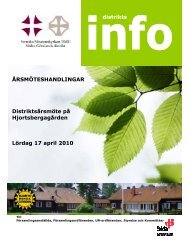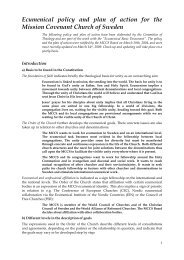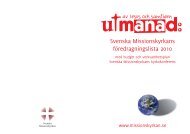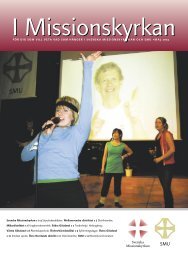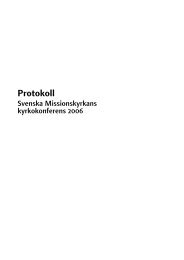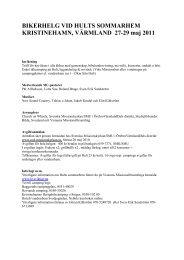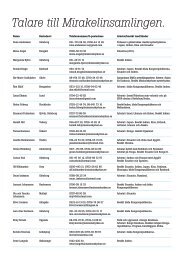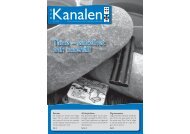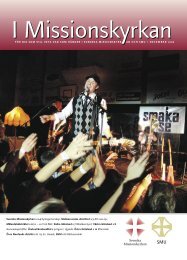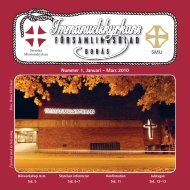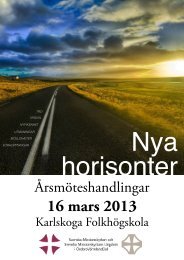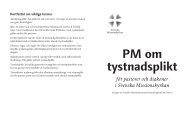Mission and Revolution in Central Asia - Svenska Missionskyrkan
Mission and Revolution in Central Asia - Svenska Missionskyrkan
Mission and Revolution in Central Asia - Svenska Missionskyrkan
Create successful ePaper yourself
Turn your PDF publications into a flip-book with our unique Google optimized e-Paper software.
weav<strong>in</strong>g through the streets <strong>in</strong> order to mislead neighbours <strong>and</strong> acqua<strong>in</strong>tances. Incredible<br />
th<strong>in</strong>gs could happen if someone got w<strong>in</strong>d of the real facts – <strong>and</strong> who does not fear the evil<br />
eye?” 35<br />
Often the midwives had to do operations <strong>and</strong> <strong>in</strong>terventions normally reserved for fully<br />
qualified doctors <strong>and</strong> that under extremely primitive conditions, <strong>in</strong> the homes of the patients.<br />
Over a period of time they were <strong>in</strong>creas<strong>in</strong>gly trusted by the population. Even well-to-do<br />
women asked them for help at child-birth. Sometimes even totally private events among the<br />
missionaries could deepen this confidence. One such example was when Mrs Nyström was<br />
giv<strong>in</strong>g birth <strong>in</strong> Jarkend <strong>in</strong> 1912, <strong>and</strong> it was a forceps delivery. This became widely known<br />
among the population. And the confidence among the population was remarkably raised<br />
where child-birth was concerned. 36<br />
The first hospital <strong>in</strong> Kashgar was built by Högberg <strong>in</strong> the year 1900. It was ru<strong>in</strong>ed <strong>in</strong> an<br />
earth-quake <strong>in</strong> 1907. Immediately afterwards a new hospital was built, a larger <strong>and</strong> better one.<br />
This time too, Högberg was the constructor. Betesta, which was the name of the hospital,<br />
attracted general public <strong>in</strong>terest. At the <strong>in</strong>auguration both the Russian <strong>and</strong> the British General<br />
Consuls were present. The Ch<strong>in</strong>ese M<strong>and</strong>ar<strong>in</strong> as well as high Ch<strong>in</strong>ese officials also attended.<br />
No less than n<strong>in</strong>e languages were spoken at the event. The guests h<strong>and</strong>ed over their gifts. One<br />
gift received special attention, the gift from the Russian Consul to Raquette, for hav<strong>in</strong>g given<br />
medical care to some Russian citizens. The gift was a golden case with jewels. 37 At this<br />
solemn <strong>in</strong>auguration, a cantata, entitled “Betesta”, composed by Högberg, was also<br />
performed. 38<br />
In Jarkend, the first <strong>Mission</strong> hospital was built by the Persian doctor Mässrur. This took<br />
place <strong>in</strong> 1896 when he <strong>and</strong> his wife Anna Nyström-Mässrur moved there <strong>and</strong> started work<strong>in</strong>g<br />
there. In 1910 a new hospital could be <strong>in</strong>augurated, built by Raquette. The new hospital had<br />
light, airy rooms both for cl<strong>in</strong>ical work, operations <strong>and</strong> <strong>in</strong>-patients. 39 In Jarkend, the <strong>Mission</strong><br />
managed to get hold of a seraglio that was turned <strong>in</strong>to sick-rooms <strong>in</strong> a native style. There the<br />
patients could be treated <strong>and</strong> far-away patients could sleep. This connection to the area was<br />
seen by the missionaries as a good complement to the traditional medical care given. 40<br />
Unfortunately similar arrangements could not be made at the other hospitals.<br />
In Jengi-Hessar medical work was taken up <strong>in</strong> 1912 by Lovisa Engvall. The hospital was<br />
built after that by Arell <strong>and</strong> Palmberg, <strong>and</strong> the first <strong>Mission</strong>ary doctor was Högberg. 41 Here<br />
Högberg carried out many successful operations <strong>and</strong> the confidence <strong>in</strong> missionary medical<br />
care grew among many people. His manifold home visits to the sick contributed to mak<strong>in</strong>g the<br />
<strong>Mission</strong> well known <strong>and</strong> respected. This town was normally a centre of learn<strong>in</strong>g with several<br />
Muslim High Schools offer<strong>in</strong>g hard resistance to the <strong>Mission</strong>. 42<br />
The Ch<strong>in</strong>ese town of Hancheng never had a hospital. However, medical care was given<br />
there on a smaller scale. Accidents for example were taken care of by medically qualified<br />
personnel. 43<br />
Instruments used by the first missionaries at surgical <strong>in</strong>terventions were of a very primitive<br />
k<strong>in</strong>d. When for <strong>in</strong>stance Högberg was suddenly faced with the <strong>in</strong>evitable fact of hav<strong>in</strong>g to<br />
operate, he had to have <strong>in</strong>struments. Sometimes his own penknife had to do as a scalpel. On<br />
other occasions he was helped by local black-smiths, who directed by him produced the<br />
35<br />
Lundahl-Walder, 1938, p. 100.<br />
36<br />
Fritzon, 1968/69, p. 8.<br />
37<br />
Palmaer, 1946, p. 72.<br />
38<br />
Lundahl, 1917, p. 395 ff.<br />
39<br />
Törnquist, 1928, p. 412.<br />
40<br />
Ibid., 466.<br />
41<br />
Ibid.,. 463.<br />
42<br />
Palmaer, 194,6 p. 76.<br />
43<br />
Törnquist, 1928, p. 464. Palmaer, 1942, p. 92.<br />
7



